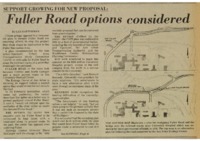Transportation Planning
Fixing Fuller Road
Each weekday at rush hour, U-M Medical Center staff, University employees and other Ann Arbor commuters converged on Fuller Road. The two-lane road, located just north of U-M’s medical campus, had not been designed to carry the amount of daily traffic it regularly carried by the late 1970s. A long debate over the expansion of Fuller Road revealed the difficulties that environmentalists faced in reversing the dominance of car-centered urban planning. Environmentalists, city planners, U-M administrators, and business owners all agreed that something needed to change, but they disagreed about what that something should be.
Both the Ann Arbor Circulation Plan and the 1975 Ann Arbor-Ypsilanti Urban Area Transportation Study (UATS) had recommended widening Fuller Road to accommodate the traffic. The Ecology Center and neighborhood associations suggested the city start by promoting alternatives to private car use — like carpooling, satellite parking, and a more efficient bus system — before resorting to construction. The University of Michigan — which threatened to relocate its medical campus if nothing changed — proposed a plan to widen Fuller Road and re-route most of the traffic over a new bridge that would cross the railway tracks further east and, in the process, bisect the fifteen-acre Fuller Recretaion Area. In mid-1978, the UATS steering committee, the AATA, and the Ann Arbor and Ypsilanti City Councils endorsed this plan and the UATS embarked upon a year-long study.
Disquieted by the negative environmental impacts of the city’s new plan to re-route Fuller Road, in January 1980 the Ecology Center proposed an alternative. The Center’s plan suggested widening Fuller Road without re-routing it, easing rush-hour traffic without disrupting the parkland below. Better yet, the EC's plan was significantly cheaper and could also be completed sooner. After debate, the UATS adopted the Ecology Center’s proposals in June 1980. Ecology Center director Steve McCargar described the adoption as “the only realistic proposal that can be retrieved from a bad situation.” This result, far from the Ecology Center’s ideal outcome, mirrored many other road construction controversies in the late 1970s and early 1980s. The financial realities of the city and the ambitious plans of the EC required compromise from both parties.


